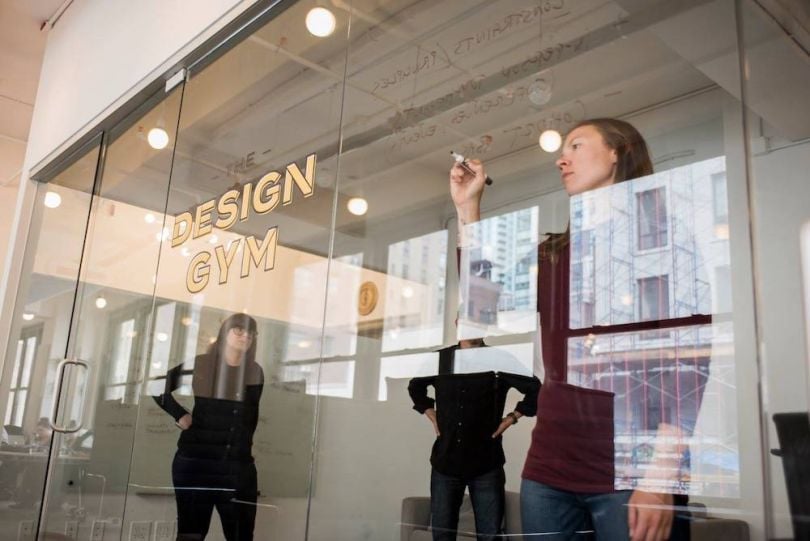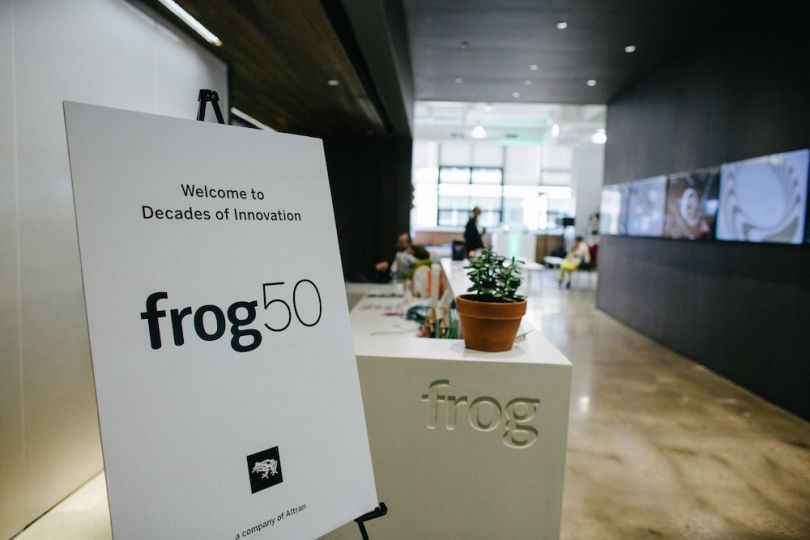When former IBM user-experience designer Adam Cutler attended his first meeting with developers back in 2001, ready to share fresh insights from his recently conducted user research, he was greeted with a surprise: the development team was already banging out code. That means they were building the thing before knowing what its target audience needed from it. “You just make it pretty on the way out the door,” Cutler, in a short documentary about IBM’s subsequent embrace of design thinking, recalls being told.
10 Design Thinking Courses to Know
- Stanford University’s d.school
- IDEO U
- Frog Design
- IBM
- Cornell University
- University of Virginia
- University of Toronto
- The Design Gym
- General Assembly
- Design Thinkers Academy
We’ve come a long way since then. Not only are concepts like user empathy and rapid prototyping central to product development, they’ve penetrated the overarching organizational philosophies of many Fortune 500 companies. That spread of so-called user-centrism — in which the “user” is anyone who uses an organization’s products or services — is core to design thinking. Boiled down to its essence, design thinking means that an organization should be chiefly focused on prioritizing users’ needs within the boundaries of technical and business realities.
With some subtle variations, the design-thinking process is generally broken down into five steps:
- Empathize: Research users’ needs
- Definition: Define the correct problem, per user research
- Ideation: Spitball all manner of solutions
- Prototype: Create solution models, quickly and cost-effectively
- Test and Launch: Confirm users’ needs are met and initiate
Like computer programming or DevOps, it’s often visualized as a loop, with implemented ideas continually feeding back into how an organization’s user base is understood. If that seems a little vague or obvious or indistinguishably similar to the user-centered design standard that sometimes guides UX designers, you wouldn’t be the first to think so. For believers, though, it’s all about results over semantics.
Here are some bootcamps where attendees can break through the hype and learn the finer points of design thinking, which is now implemented at the highest levels.
In-Person Courses

The Design Gym’s Design Thinking Bootcamp
This NYC-based consultancy boasts a roster of high-wattage clients, including CBS, Facebook, Cisco and Capital One. Specializing in corporate training, culture change and project sprints, it also hosts day-long design-thinking bootcamps in NYC that cover the essentials and explore notable implementation stories like GE and Marriott. Toe-dippers can opt for a cheaper sampler: the semi-regular three-hour Design Thinking Crash Course ($60).
Cost: $595

General Assembly’s Design Thinking Bootcamp
Continuing-ed pioneer General Assembly remains highly regarded for its software, UX and data science coursework. It’s also in the DT game, with a reasonably priced, single-day onsite option available. As of this writing, only one installment (in Chicago) is listed on GA’s near-term calendar, but interested parties should keep an eye out. Past boot camps have been offered in Atlanta, Boston, San Francisco and Washington, DC. Although GA has some online courses, the DT bootcamp is not among them.
Cost: $195

ASPE Training’s Design Thinking Bootcamp
This two-day bootcamp is available both online and in-person. The curriculum includes problem-framing, convergent-versus-divergent thinking, rapid prototyping, and using agile practices to iterate. Students also explore how to overcome common challenges in terms of implementation, including engineering obstacles and employing the philosophy at scale. The in-person sequence is available in several North American cities, including San Francisco, NYC, Chicago, Seattle, Denver and more.
Cost: $2,295

Design Thinkers Academy’s 2-Day Design Thinking Facilitation Course
Amsterdam-based management consultancy Design Thinkers Group has taught the gospel of design thinking at the corporate level to the likes of L'Oréal and Coca-Cola. Its professional-development arm, the Academy, teaches the same fundamentals to individuals and teams. Most courses take place at its Holland HQ and other international locales, but it has a stateside presence in Greenville, South Carolina, where it hosts a two-day workshop. Check the U.S. calendar for up-to-date listings or subscribe to DTA’s newsletter to monitor additions.
Cost: $1,900

Global Knowledge’s Design Thinking Bootcamp
This two-day bootcamp is offered at many locations throughout the U.S. (San Francisco, Philadelphia, NYC, Washington, D.C., Atlanta, San Diego, Minneapolis, Chicago, Dallas, Dulles, Denver and Seattle). It’s also available online as an instructor-led virtual classroom rather than just a collection of produced videos.
Cost: $2,295
University-Affiliated Courses

Stanford University’s Design Thinking Bootcamp: From Insights to Innovation
Stanford’s Hasso Plattner Institute of Design, more commonly stylized as d.school, was launched by IDEO co-founder David Kelley, the man credited more than any other with popularizing design thinking. So it’s safe to say this full-time, four-day intensive has its bona fides cemented. And while it’s by far the priciest option listed here, that institutional cred, an all-encompassing curriculum and strong alumni roster make it a must-consider — even if you must travel to attend. Sessions are offered in spring, summer and fall.
Cost: $13,000

MIT School of Management’s Mastering Design Thinking
This roughly three-month online course, designed by one of the nation’s preeminent business schools and comprised of 128 video lectures, covers the DT basics as well as more advanced subject matter like financial modeling for projects and green product design approaches. Additionally, it has a dedicated learning module for service design and three live teaching sessions to inject some personalization. Courses in 2020 run from March 12 through June 3 and June 18 through September 9. Students can expect to devote about six to eight hours weekly.
Cost: $3,300

Harvard Division of Continuing Education’s Design Thinking: Creating Better Customer Experiences
The popular Harvard Extension School teaches the design-thinking fundamentals at this two-day, onsite bootcamp, as broken into four categories: learn, design, test and model. Students also look at prototyping from the perspective of minimum viability and explore how to foster adoption of design thinking within an organization. Instructors include Dave Power, CEO of the renowned Perkins School for the Blind, which has turned to design thinking for projects like its app that helps blind commuters navigate the Boston-area public transportation system.
Cost: $2,895

Columbia College’s Design Thinking for Creative Problem Solving
This eight-week online course teaches design thinking along the traditional steps as outlined by the d.school, but also through some off-the-beaten-path examples of where the philosophy has been applied, including urban planning, architecture and healthcare. The course was created by Kevin Henry, an associate professor of design at Chicago’s Columbia College and author of Drawing for Product Designers.
Cost: $500

Cornell University’s Design Thinking Certificate
Launched in 2018 and developed by a lecturer at the Cornell College of Engineering, this sequence spans six three-week courses that cover the following: framing challenges around user needs; understanding user emotions; building user narratives; brainstorming solutions; prototyping; and testing and iteration. Students can expect to devote between three and five hours per week and complete multiple choice quizzes in each course, plus a final project. Courses include instructor-moderated discussions.
Cost: $3,600

University of Toronto — Rotman’s Business Design Fundamentals
Perhaps best known in tech circles as the home of seed-stage incubator Creative Destruction Lab, the University of Toronto’s Rotman School of Management is also an in-demand destination for executive-level professional development north of the border. (Well-known business strategist Roger Martin, who helped vault design thinking into the broader consciousness, was the longtime dean of Rotman.) This onsite, two-day intensive starts with an introduction to design-thinking methods, then launches into the finer points of business design sprints. The course was designed and is taught by lecturer Angèle Beausoleil, who penned a case for design thinking last year in Salon.
Cost: $4,250 CAD

University of Virginia’s Darden School of Business’ Design Thinking & Innovation Specialization
This deep-dive online sequence — four five-week courses — is led by strategist and UVA senior associate dean for degree programs Jeanne Liedtka, who has penned several books on design thinking. Topics covered include five tools for human-centered design and balancing short term and long term goals.
Cost: $1,600

Rochester Institute of Technology’s MicroMasters Program in Design Thinking
RIT offers perhaps the most exhaustive overview available online: Its so-called MicroMasters program spans eight months and covers five distinct six-week courses. Start with the Fundamentals overview, then decide if you want to press on into subsequent dedicated courses, which cover user empathy and problem framing, ideation and iteration, prototyping and user testing and a final capstone.
Cost: $900 with certificate / Free without certificate
Online Courses

IDEO U’s Hello Design Thinking
Along with Stanford’s d.school, IDEO is the institution most synonymous with design thinking. David Kelly, who helped pioneer its core concept of user-centrism way back in the ‘80s, co-founded the Palo Alto consulting firm. And Tim Brown was the company’s CEO when, in 2008, Harvard Business Review published his watershed “Design Thinking” article, which effectively brought the approach to boardrooms nationwide. This self-paced video course, presented by Kelley, delivers all the must-knows from the man who helped formulate them.
Cost: $199

Cooper Professional Education’s Cooper Crash Course: Design Thinking in 3 Steps
Designed by noted programmer, educator and Twitter star Alan Cooper, this online course — available via Udemy, where it's a high-rated bestseller — breaks the philosophy into three categories: understanding users, envisioning creative solutions and, of course, prototyping. Balancing video (one-and-a-half hours of lecture material) with articles and downloads, it’s self-paced, affordable and light on assignments. Think of it as a low-stress primer compared to some of the more rigorous intensives. Cooper Professional Education also offers a Design Thinking Certificate, comprised of three two-day, in-person courses, each available stateside in New York and San Francisco.
Cost: $194.99

Frog Design’s Learn Design Thinking: Lead Change in Your Organization
The famed German studio Frog Design cemented its legacy in design annals decades ago with the Snow White aesthetic, which Apple then pushed to legendary heights. It has since expanded greatly, including into the management consulting sphere, where it channels design fundamentals into business strategy. Such counsel is beyond the pocketbook of mere individual professional development seekers, but you can still get a CliffsNotes-esque sampling of the goods via Frog’s two-hour video course, designed by Frog’s Turi McKinley.
Cost: Free with subscription.

Berkeley Innovation Group’s Design Thinking
Led by two instructors from UC Berkeley’s Haas School of Business, this six-week online course is distributed via Knowdeon. It starts with an introduction to design-thinking basics and concludes with a look at the so-called Monday morning challenge (i.e. overflowing inboxes after devoting so much time to a design sprint) and hits on all the fundamentals in between. Guest speakers include Elizabeth Glenewinkel, director of strategic innovation at Salesforce.
Cost: $1,200

Interaction Design Foundation’s Design Thinking: The Beginner’s Guide
This Danish open-source nonprofit offers nearly 30 courses framed around user experience, including a 12-hour design-thinking intro. Popular and highly rated within the platform, the seven-week course (one lesson is available per week) is structured along the traditional design-thinking framework of building user empathy, problem definition, ideation and prototyping and testing.
Cost: Free with IDF subscription ($13 monthly)

Microsoft’s Introduction to Design Thinking
No less than the Bill Gates empire has embraced the call of design thinking. Student turns teacher in this free, five-week Microsoft-sponsored course, available on edX. The curriculum covers essentials like rapid prototyping and how to glean the most from user interviews, while also touching on user interface design. Participants can expect to devote between three and four hours per week.
Cost: Free

IBM’s Enterprise Design Thinking Courses
It was big news when IBM embraced design thinking. As the New York Times explored in its 2015 dive into the tech giant’s pivot to DT, the company had a history of management flexibility and a rich design legacy, exemplified by its Eliot Noyes halcyon days, but was now a massive legacy brand. Implementing design thinking at such scale was ambitious stuff. As DT advocates know, IBM loved the results, and in 2018 began offering online design thinking courses built around its own experience. Current courses range from short and specialized (a three-hour application of design thinking to AI) to intensive (a three- to six-week team-based lesson sequence).
Cost: $300 (full access)





